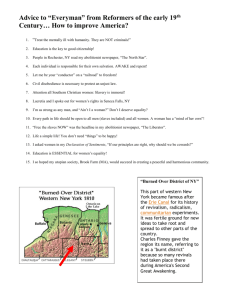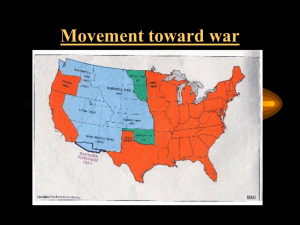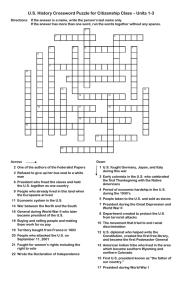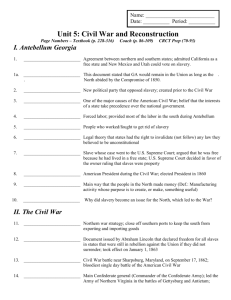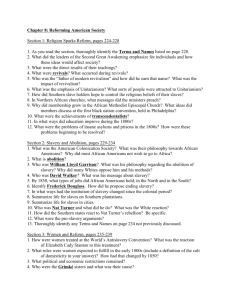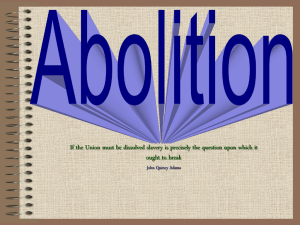File - Gracie Magyar
advertisement
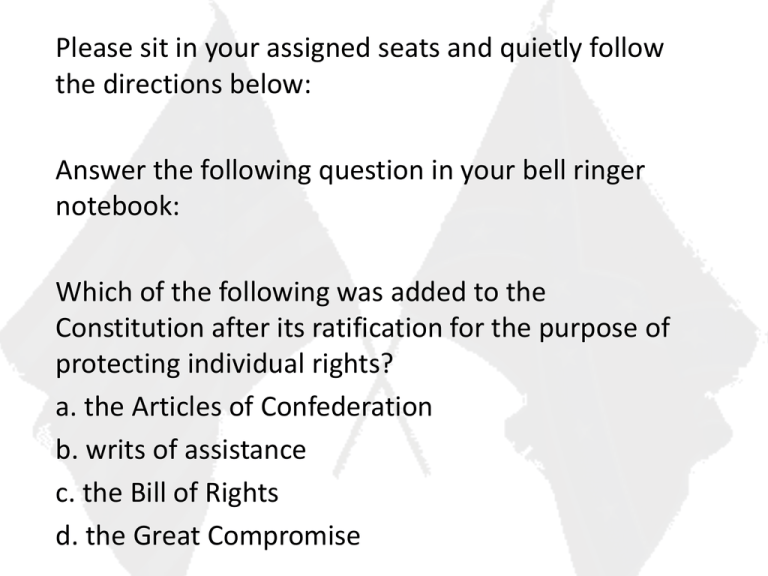
Please sit in your assigned seats and quietly follow the directions below: Answer the following question in your bell ringer notebook: Which of the following was added to the Constitution after its ratification for the purpose of protecting individual rights? a. the Articles of Confederation b. writs of assistance c. the Bill of Rights d. the Great Compromise 1. Define “antebellum period”. 2. When we talk about the antebellum period, we’re talking about the time period before which war? 3. Why did social and culture differences emerge in each region? 4. Increased regional pride led to _______________________. 5. What worsened the tensions between the North and South regions? 6. Name two ways the culture in the North was affected by the people who settled and lived there. 7. Why was education established in New England? 8. Why was education expanded in the antebellum period in the North? 9. What type of political issues did Northerners support? 10. How did the privileged class in the South develop? 11. True or False: Most southerners lived on family farms and did NOT own slaves during the antebellum period. 12. Describe education in the South. 13. Why were immigrants not attracted to the Southern region? 14. What type of political issues did Southerners support? 15. Which part of the West reflected the cultural values of New England? 16. Which part of the West reflected the cultural values of the Southern region? 17. How did Manifest Destiny affect the West? 18. What type of political issues did the West support? USHC Standard 2: The student will demonstrate an understanding of how economic developments and the westward movement impacted regional differences and democracy in the early nineteenth century. USHC 2.4: Compare the social and cultural characteristics of the North, the South, and the West during the antebellum period, including the lives of African Americans and social reform movements such as abolition and women’s rights. What was life like for African Americans in the North? • Although the Northern states had begun to emancipate their slaves right after the Declaration of Independence, some Northern states continued to have slaves in the 1830s • Slavery was prohibited in the old Northwest by the Northwest Ordinance • Free blacks lived in the North, but could not exercise the same rights as whites, except to legally marry • In the North, African Americans were purposefully disenfranchised by law at the same time the universal manhood suffrage was established • Disenfranchise: to deprive (a person) of the right to vote or other rights of citizenship • Suffrage: the right to vote • African Americans were often the last hired and the first fired and did the jobs that were least attractive • Segregation was practiced throughout the North What was life like for African Americans in the South? • Most African Americans living in the South were slaves • The conditions of slaves’ lives depended in large part on where they lived and the kindness of their masters • The freedmen that lived in the South lived mostly in cities where they could find work as artisans • The job opportunities for freedmen in the South were better than in the North because many of them had skills that were in high demand • Freedmen in the South were not granted civil or political rights, and were not even considered American citizens REFORM: to form again Why did reform movements begin to develop in the United States during the antebellum period? The religious revival movement [the Great Awakening] of the early 1800s was national in scope and contributed to the development of reform movements that further divided the nation ABOLITION The Abolitionist Movement: • Abolition: the legal prohibition and ending of slavery, especially of slavery of blacks in the U.S. • The abolitionist movement first developed among Quakers who believed that everyone, even slaves, had an inner light • Abolitionists included African Americans such as Nat Turner, Frederick Douglass and Harriet Tubman, and whites such as William Lloyd Garrison, the Grimke sisters, Harriet Beecher Stowe, and John Brown who engaged in a variety of different protest activities • Abolitionists published newspapers and organized antislavery conventions, wrote books and helped slaves escape the through the Underground Railroad • Abolitionists also led rebellions Weaknesses of the Abolitionist Movement: • The activities of abolitionists led to the strengthening of the resolve of slave owners to justify their culture, which further divided the nation • Southerners argued that slavery was a “positive good” because slaves were better off than industrial workers in the North • Most northerners were NOT abolitionists • Some abolitionists did not believe that freed slaves should have equal rights • The abolitionist movement split over the issue of whether or not to engage in the political process • They also had internal disagreements about whether or not to recognize the rights of women to speak in public against slavery • Abolition was not effective until the controversy over western expansion led to political intervention (Abraham Lincoln and the Republican Party) Women’s Rights Elizabeth Cady Stanton Lucretia Mott What about women’s rights? • The women’s rights movement was active in the North and tied to the abolitionist movement • Elizabeth Cady Stanton and Lucretia Mott met and were determined to advocate for women’s rights when they were denied the right to participate at an abolitionist convention • Stanton and Mott organized the Seneca Falls (New York) Convention in 1848, which called for women’s rights • Women were protesting second class citizenship for many reasons: 1. Limited access to education 2. Limited rights to own and control property 3. Limited rights to obtain a divorce • The women’s rights movement was not successful in the antebellum period in securing additional rights for women
